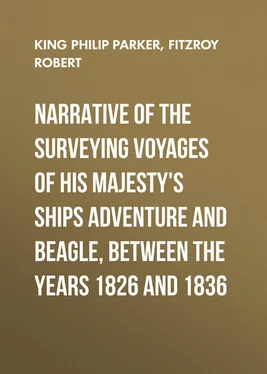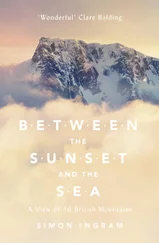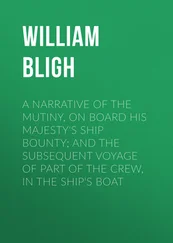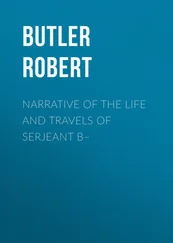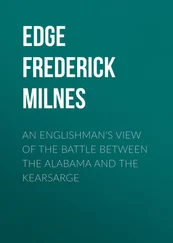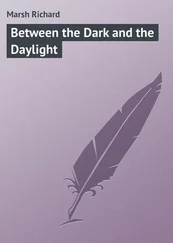Robert Fitzroy - Narrative of the surveying voyages of His Majesty's ships Adventure and Beagle, between the years 1826 and 1836
Здесь есть возможность читать онлайн «Robert Fitzroy - Narrative of the surveying voyages of His Majesty's ships Adventure and Beagle, between the years 1826 and 1836» — ознакомительный отрывок электронной книги совершенно бесплатно, а после прочтения отрывка купить полную версию. В некоторых случаях можно слушать аудио, скачать через торрент в формате fb2 и присутствует краткое содержание. Издательство: Иностранный паблик, Жанр: foreign_antique, foreign_prose, на английском языке. Описание произведения, (предисловие) а так же отзывы посетителей доступны на портале библиотеки ЛибКат.
- Название:Narrative of the surveying voyages of His Majesty's ships Adventure and Beagle, between the years 1826 and 1836
- Автор:
- Издательство:Иностранный паблик
- Жанр:
- Год:неизвестен
- ISBN:нет данных
- Рейтинг книги:3 / 5. Голосов: 1
-
Избранное:Добавить в избранное
- Отзывы:
-
Ваша оценка:
- 60
- 1
- 2
- 3
- 4
- 5
Narrative of the surveying voyages of His Majesty's ships Adventure and Beagle, between the years 1826 and 1836: краткое содержание, описание и аннотация
Предлагаем к чтению аннотацию, описание, краткое содержание или предисловие (зависит от того, что написал сам автор книги «Narrative of the surveying voyages of His Majesty's ships Adventure and Beagle, between the years 1826 and 1836»). Если вы не нашли необходимую информацию о книге — напишите в комментариях, мы постараемся отыскать её.
Narrative of the surveying voyages of His Majesty's ships Adventure and Beagle, between the years 1826 and 1836 — читать онлайн ознакомительный отрывок
Ниже представлен текст книги, разбитый по страницам. Система сохранения места последней прочитанной страницы, позволяет с удобством читать онлайн бесплатно книгу «Narrative of the surveying voyages of His Majesty's ships Adventure and Beagle, between the years 1826 and 1836», без необходимости каждый раз заново искать на чём Вы остановились. Поставьте закладку, и сможете в любой момент перейти на страницу, на которой закончили чтение.
Интервал:
Закладка:
The only weapons which we observed with these people were the 'bolas,' or balls, precisely similar to those used by the Pampas Indians; but they are fitter for hunting than for offence or defence. Some are furnished with three balls, but in general there are only two. These balls are made of small bags or purses of hide, moistened, filled with iron pyrites, or some other heavy substance, and then dried. They are about the size of a hen's egg, and attached to the extremities of a thong, three or four yards in length. To use them, one ball is held in the hand, and the other swung several times around the head until both are thrown at the object, which they rarely miss. They wind round it violently, and if it be an animal, throw it down. The bolas, with three balls, similarly connected together, are thrown in the same manner.
As more time could not be spared we went on board, reminding the natives, on leaving them, of their promise to bring us some guanaco meat. Aided by the tide, the ships worked to windward through the Second Narrow, and reached an anchorage out of the strength of tide, but in an exposed situation. The wind having been very strong and against the tide, the ship had much motion, which made our Patagonian passengers very sick, and heartily sorry for trusting themselves afloat. One of them, with tears in his eyes, begged to be landed, but was soon convinced of the difficulty of compliance, and satisfied with our promise of sending him ashore on the morrow.
After we anchored, the wind increased to a gale, in which the ship pitched so violently as to injure our windlass. Its construction was bad originally, and the violent jerks received in Possession Bay had done it much damage. While veering cable, the support at one end gave way, and the axle of the barrel was forced out of the socket, by which some of the pawls were injured. Fortunately, dangerous consequences were prevented, and a temporary repair was soon applied.
The Beagle, by her better sailing, had reached a more advanced situation, close to the N.E. end of Elizabeth Island, but had anchored disadvantageously in deep water, and in the strength of the tide. Next morning we made an attempt to pass round Elizabeth Island, but found the breeze so strong that we were forced to return, and were fortunate enough to find good anchorage northward of the island, out of the tide.
The Patagonians, during the day, showed much uneasiness at being kept on board so much longer than they expected; but as they seemed to understand the cause of their detention, and as their sickness ceased when we reached smooth water, they gradually recovered their good-humour, and became very communicative. As well as we could understand their pronunciation, their names were 'Coigh,' 'Coichi,' and 'Aighen.' The country behind Cape Negro they called 'Chilpéyo;' the land of Tierra del Fuego, 'Oschērri;' Elizabeth Island, 'Tŭrrĕtterr;' the island of Santa Magdalena, 'Shrēe-ket-tup;' and Cape Negro, 'Oērkrĕckur.' The Indians of Tierra del Fuego, with whom they are not on friendly terms, are designated by them 'Săpāllĭŏs.' This name was applied to them in a contemptuous tone.
Aighen's features were remarkably different from those of his companions. Instead of a flat nose, his was aquiline and prominent, and his countenance was full of expression. He proved to be good-tempered, and easily pleased; and whenever a shade of melancholy began to appear, our assurance of landing him on the morrow restored his good-humour, which was shown by singing and laughing.
The dimensions of Coichi's head were as follows: —
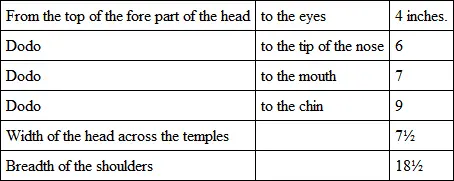
The head was long and flat, at the top; the forehead broad and high, but covered with hair to within an inch and a half of the eyebrow, which had scarcely any hair. The eyes were small, the nose was short, the mouth wide, and the lips thick. Neck short, and shoulders very broad. The arms were short, and wanting in muscle, as were also the thighs and legs. The body was long and large, and the breast broad and expanded. His height was nearly six feet.
The next day we rounded Elizabeth Island, and reached Cape Negro, where we landed the Indians, after making them several useful presents, and sending some trifles by Aighen to Maria, who, with her tribe, had lighted large fires about the country behind Peckett's Harbour, to invite us to land. Our passengers frequently pointed to them, telling us that they were made by Maria, who had brought plenty of guanaco meat for us.
Our anxiety to reach Port Famine prevented delay, and, as soon as the boat returned, we proceeded along the coast towards Freshwater Bay, which we reached early enough in the afternoon to admit of a short visit to the shore.
From Cape Negro the country assumed a very different character. Instead of a low coast and open treeless shore, we saw steep hills, covered with lofty trees, and thick underwood. The distant mountains of Tierra del Fuego, covered with snow, were visible to the southward, some at a distance of sixty or seventy miles.
We had now passed all the difficulties of the entrance, and had reached a quiet and secure anchorage.
The following day was calm, and so warm, that we thought if Wallis and Cordova were correct in describing the weather they met with, Duclos Guyot was equally entitled to credit; and we began to hope we had anticipated worse weather than we should experience. But this was an unusually fine day, and many weeks elapsed, afterwards, without its equal. The temperature of the air, in the shade on the beach, was 67½°, on the sand 87½°; and that of the water 55°. Other observations were made, as well as a plan of the bay, of which there is a description in the Sailing Directions.
Here we first noticed the character of the vegetation in the Strait, as so different from that of Cape Gregory and other parts of the Patagonian coast, which is mainly attributable to the change of soil; the northern part being a very poor clay, whilst here a schistose sub-soil is covered by a mixture of alluvium, deposited by mountain streams; and decomposed vegetable matter, which, from the thickness of the forests, is in great quantity.
Two specimens of beech ( Fagus betuloides and antarctica ), the former an evergreen, – and the winter's bark ( Wintera aromatica ), are the only trees of large size that we found here; but the underwood is very thick, and composed of a great variety of plants, of which Arbutus rigida , two or three species of Berberis , and a wild currant ( Ribes antarctica , Bankes and Solander MSS.), at this time in flower, and forming long clustering bunches of young fruit, were the most remarkable. The berberis produces a berry of acidulous taste, that promised to be useful to us. A species of wild celery, also, which grows abundantly near the sea-shore, was valuable as an antiscorbutic. The trees in the immediate vicinity of the shore are small, but the beach was strewed with trunks of large trees, which seemed to have been drifted there by gales and high tides. A river falls into the bay, by a very narrow channel, near its south end; but it is small, and so blocked up by trees as not to be navigable even for the smallest boat: indeed, it is merely a mountain torrent, varying in size according to the state of the weather.
Tracks of foxes were numerous about the beach, and the footsteps of a large quadruped, probably a puma, were observed. Some teal and wild ducks were shot; and several geese were seen, but, being very wary, they escaped.
Upon Point St. Mary we noticed, for the first time, three or four huts or wigwams made by the Fuegian Indians, which had been deserted. They were not old, and merely required a slight covering of branches or skins to make them habitable. These wigwams are thus constructed: long slender branches, pointed at the end, are stuck into the ground in a circular or oval figure; their extremities are bent over, so as to form a rounded roof, and secured with ligatures of rush; leaving two apertures, one towards the sea, and the other towards the woods. The fire is made in the middle, and half fills the hut with smoke. There were no Indians in the bay when we arrived, but, on the following evening, Lieutenant Sholl, in walking towards the south end of the bay, suddenly found himself close to a party which had just arrived in two canoes from the southward. Approaching them, he found there were nine individuals – three men, and the remainder women and children. One of the women was very old, and so infirm as to require to be lifted out of the canoe and carried to the fire. They seemed to have no weapons of any consequence; but, from our subsequent knowledge of their habits, and disposition, the probability is they had spears, bows, and arrows concealed close at hand. The only implement found amongst them was a sort of hatchet or knife, made of a crooked piece of wood, with part of an iron hoop tied to the end. The men were very slightly clothed, having only the back protected by a seal's skin; but the females wore large guanaco mantles, like those of the Patagonian Indians, whom our pilot told us they occasionally met for the purpose of barter. Some of the party were devouring seal's flesh, and drinking the oil extracted from its blubber, which they carried in bladders. The meat they were eating was probably part of a sea lion ( Phoca jubata ); for Mr. Sholl found amongst them a portion of the neck of one of those animals, which is remarkable for the long hair, "like a lion's mane," growing upon it. They appeared to be a most miserable, squalid race, very inferior, in every respect, to the Patagonians. They did not evince the least uneasiness at Mr. Sholl's presence, or at our ships being close to them; neither did they interfere with him, but remained squatting round their fire while he staid near. This seeming indifference, and total want of curiosity, gave us no favourable opinion of their character as intellectual beings; indeed, they appeared to be very little removed from brutes; but our subsequent knowledge of them has convinced us that they are not usually deficient in intellect. This party was perhaps stupified by the unusual size of our ships, for the vessels which frequent this Strait are seldom one hundred tons in burthen.
Читать дальшеИнтервал:
Закладка:
Похожие книги на «Narrative of the surveying voyages of His Majesty's ships Adventure and Beagle, between the years 1826 and 1836»
Представляем Вашему вниманию похожие книги на «Narrative of the surveying voyages of His Majesty's ships Adventure and Beagle, between the years 1826 and 1836» списком для выбора. Мы отобрали схожую по названию и смыслу литературу в надежде предоставить читателям больше вариантов отыскать новые, интересные, ещё непрочитанные произведения.
Обсуждение, отзывы о книге «Narrative of the surveying voyages of His Majesty's ships Adventure and Beagle, between the years 1826 and 1836» и просто собственные мнения читателей. Оставьте ваши комментарии, напишите, что Вы думаете о произведении, его смысле или главных героях. Укажите что конкретно понравилось, а что нет, и почему Вы так считаете.
